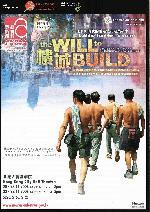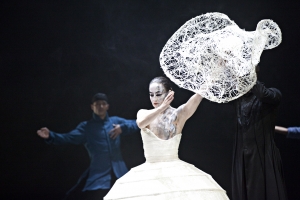 |
The Will to Build (樓城) was a “Verbatim Theatre” performance devised by Theatre du Pif led by Director, Ms. Bonni Chan. The topic is to explore the spatial problem of Hong Kong and the related issues on the city life and culture. In preparing the performance, the production team started by interviewing about 40 interviewees, including construction workers, property developers, architects, residents in Tin Shui Wai, city planners, heritage activists, etc. They used the real words from the interviewees to construct the performance.
According to the Notes from UK Dramaturg, Mr. Liam Hurley who participated in the performance, “Verbatim Theatre …seeks to be very faithful to the source interview material, prompting interesting questions for the creative process – Does a performer create their own character from the interview material as they would if they were acting in a conventionally scripted piece? Or do they attempt to mimic the speaker, even right down to speech patterns and pauses for breath, in an attempt at a new kind of theatrical ‘truthfulness’. The results of such an approach can be very powerful, if done well.”
The stage design was quite simple. There were 2 transparent rooms (or boxes), one on the left and one on the right of the stage. At the opening of the performance, there were digital images showing flashing and moving arrows in the rooms. Initially, only few arrows were moving into the boxes. Then, more and more arrows moved into the room on the left, and the performers squeezed into it one by one, symbolizing that more and more people were moving intoHong Kong and fighting for space. This set the theme of the whole performance. Throughout the performance, video, music and audio effects were made from time to time. The performers acted in different scenes. Some of the scenes were a short piece in the form of conventional scripts, but some were not.
It first brought audience to the old Hong Kong under the British colonial rule. It talked about history of Hong Kong’s constructions for residence, e.g. early squatters on hills in Hong Kong, the big fire which demolished Shek Kip Mei squatters, the later building of 7-storey estates, and then the crowded living environment of the general Hong Kong people nowadays.
The performers made various body movements, danced or acted out different scenes to describe what happened or what is happening in Hong Kongalong the spatial issue, or express opinions or views, etc. But the theme actually extended to the city life and culture of Hong Kong, e.g. Hong Kong people are too busy, we need to be lonely, we need space, space to change.
Undoutedly, the lines of scripts and the opinions on the stage were mostly originated from the interviewees. However, the performers did not actually act out the interviewees’ characteristics. They merely used the interviewees’ words and opinions in their scripts.
I found some parts of the performance rather confusing. Sometimes, I did not know whom the performers were acting. I had to refer to the program leaflet which explicitly states which performers play which role(s) afterwards. This may be because they did not mimic the interviewees, and some of them were playing different roles at different times, seemingly without having changed any costumes. For example, the male performers may simply wear the same suits in different roles.
Even though I could sometimes know the characters, e.g. Shih Wing-ching, Chip Tsao and Christine Loh in the scene of a classroom setting (as they were introduced on the stage), I was side-tracked by their relationships and could not know the connections between their different statements and opinions. This may reveal that various piecemeal words from different interviewees may not make much sense when being put together in the same scene.
It is noteworthy that during the respective interviews, the interviewees spoke in their own context of interview dialogues and from their own view point. Quoting only part of the dialogues may cause lose of their initial impact or meaning in the interview dialogues. For example, in one scene, it talked about pedestrians in Central all wear suits and they may all live in crowded living environment in their childhood. This may be interesting in the initial interview dialogues. However, as this was quoted alone and was not immediately further elaborated, it could not lead me further.
Another problem is found in the video creation. Most of the video images were digital. They may be too “cold” and was unable to touch the audience. In one scene, it talked about the fire in Shek Kip Mei squatters. Mere narrations and a not rigorous red fire visual effect were used on the stage. The impact as a whole was not striking at all. In another scene, it talked about building of City One in Shatin, which was originally a swamp. Again, they just talked and talked. The impact may have been greater if 2 photographs contrasting the sites in the past and nowadays were projected by video, as a picture paints a thousand words.
Sometimes, the video creation was simply missing when it should have been there. In one scene, a performer imitated a construction worker. He said “Hong Kong buildings were built by sweat and blood. Look at my heads.” He raised his beautiful hands. My feeling was just odd. It would have been totally different if we were shown a close-up shot of the construction worker’s coarse hands by video.
In view of the above, it seems that the performance was not successfully in adopting the “Verbatim Theatre” approach of seeking to be very faithful to the source interview material and be powerful. As Mr. Liam Hurley said in the post-performance discussion, this performance may not be a conventional or classic “Verbatim Theatre” production; and to my disappointment, the impact was not powerful either.
Having said the above, I did find some scenes were creative and could paint vivid images reinforcing the theme. For example, in the scene about bidding for the job of building designer by several award-winning architects who could offer the lowest price, the performers stood in a line. They first squatted down to indicate their willingness to cut their price. Ultimately, the 2 of them offering the lowest prices lay down on the ground. In other 2 scenes, it talked about showing the abnormal uniqueness of the city’s buildings (e.g. closely similar shopping malls) and the monotony of Hong Kong city life. The performers imitated themselves struggling in a typhoon and strived for their body balance in a state lacking in equilibrium. The visual impact was good and the lines could be well memorized e.g. we have a choice (pause) of sameness. All had a fine match with the video, music and audio effects.
I also really appreciate the sincerity of the production team. They had spent lot of time and effort in collecting interview materials to create the production. It also extended the topic into a discussion on the general city life in Hong Kong. It was enlightening to a certain extent. In this connection, I feel the English name“The Will to Build” is better than the Chinese name “樓城” which literally means “buildings and cities”, because the former is open-ended and whereas the latter is not. In fact, the production team wants to talk about the will to build Hong Kong buildings, to build Hong Kong people’s spirits and to build Hong Kong people’s better city life or future, etc. Obviously, the English name gave us more room for imagination.
本網站內一切內容之版權均屬國際演藝評論家協會(香港分會)及原作者所有,未經本會及/或原作者書面同意,不得轉載。









